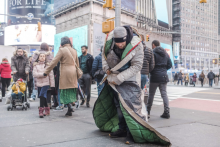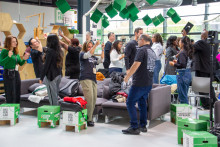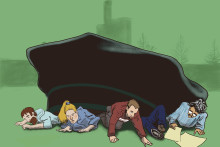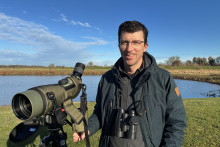Master student Edo de Wolf (Human Media Interaction) was DesignLab’s project coordinator of the Urban Safety Kit - U-Today interviewed him at the time. Interested in an update we recently contacted him again.
Reality bites
 ‘At the beginning of the project, we were all sort of in a fantasy stage. We though ‘OK, we have these great ideas, so let’s make prototypes and test them!’ But as the project went on, the Urban Safety Kit turned out to be far more complicated than other projects in our studies up until then. Somehow this target user, homeless individuals, was very tricky to deal with. Things like time and budget constraints were a huge thing as well. We got some funding, but it wasn’t a lot: 50,000 euros, shared between us and the Sheltersuit Foundation and CitiLab in Barcelona. And working with Sheltersuit was very compelling but also quite demanding. Sheltersuit was – understandably – primarily focused on the production and distribution of thousands Sheltersuits. I think an experimental project like this was quite high risk for them.’
‘At the beginning of the project, we were all sort of in a fantasy stage. We though ‘OK, we have these great ideas, so let’s make prototypes and test them!’ But as the project went on, the Urban Safety Kit turned out to be far more complicated than other projects in our studies up until then. Somehow this target user, homeless individuals, was very tricky to deal with. Things like time and budget constraints were a huge thing as well. We got some funding, but it wasn’t a lot: 50,000 euros, shared between us and the Sheltersuit Foundation and CitiLab in Barcelona. And working with Sheltersuit was very compelling but also quite demanding. Sheltersuit was – understandably – primarily focused on the production and distribution of thousands Sheltersuits. I think an experimental project like this was quite high risk for them.’
The concept
‘Originally the Urban Safety Kit had three focal points: medical safety (to detect hypothermia), personal safety (protection from violence) and connectivity (to charge smart phones). But some goals turned out to be very, very complicated. There were all kinds of things that we could not really account for. For instance, experts at MST who actually treat hypothermic people reported that even in a fully equipped hospital it is quite challenging to figure out exactly whether a person has hypothermia or not. Our idea of using sensors to detect a specific frequency of shivering that is correlated with hypothermia, was too optimistic. Furthermore, smart wearables need to be quite tight fit to measure a person's physiological factors, but Sheltersuit is made in fits all sizes.’
'The Urban Safety Kit did not get a follow up, but still it was a very rewarding experience'
No idea
‘We assumed that we could have a user test in the early stage of the project, but it was very hard to find homeless individuals to check if our assumptions were correct. We had no idea how to get in touch with homeless individuals, how to design for them and how to take into account the politics around homelessness. For instance, we got remarks on why we were developing suitable technology for homeless people instead of helping them to find a home. When you work on projects that have such a societal friction or impact, I think you need to somehow be able to understand your target group, or work with them properly. We lacked the expertise of the target user that we needed to make the most impact.’
Adjusted goals
‘Just like the medical part the personal safety part also turned out to be quite challenging. We thought about scenarios when homeless people are asleep and what kind of dangers they may find themselves in. What if someone is attacked, robbed, or even set on fire (yes, it happens…) – how can that be sensed? Since we had nobody who could tell us these stories in more detail, it was very hard to design for these scenario’s. All those things made us drop both the medical and safety aspects. The main thing we ended up working on was a solar powerbank, to enable the homeless to charge a smartphone.'
Much wanted feedback
‘We built a number of prototypes and shipped them to a living lab in Barcelona called CitiLab, which managed to get a couple of volunteer homeless individuals who were willing to participate in some kind of user testing. The testers used the prototypes for a week or two and then our Barcelona partner got their feedback on how they felt and other points and issues with the prototypes. Often their feedback was not expected. And that is the whole deal with prototypes: you want them to get to users as fast as possible, to get their feedback as soon as possible. But we underestimated the time it took to get to that point. It took us until the end of the project to obtain feedback, when we could not really do much anymore because the project had to come to a close. In the future, I would do this differently: don’t start with the prototype immediately, but first try to understand the issue at hand.’
Rewarding experience
‘As academic students we were highly focussed on the research and the findings, and a lot less on how to bring this concept to homeless individuals. We would have needed much more time and more budget to design a product to actually put out there in the world. The Urban Safety Kit did not get a follow up, but still it was a very rewarding experience. Despite the setbacks it was a fantastic opportunity to work on such a relevant real life case, with an organization that does such good like Sheltersuit. At the moment I'm still finishing my thesis; in February hopefully all will be done. But even though I took a bit longer with my studies I am glad that I have this project under my belt. I have learned some very valuable lessons and built important connections. Next time I end up doing something like this, I am much more prepared about the challenges that will arise. It was a very interesting journey and I don't think I will ever forget it.’







